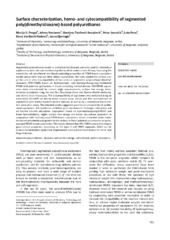Приказ основних података о документу
Surface characterization, hemo-and cytocompatibility of segmented poly(dimethylsiloxane)-based polyurethanes
| dc.creator | Pergal, Marija V. | |
| dc.creator | Brkljačić, Jelena | |
| dc.creator | Tovilović-Kovačević, Gordana | |
| dc.creator | Jovančić, Petar | |
| dc.creator | Pezo, Lato | |
| dc.creator | Vasiljević-Radović, Dana | |
| dc.creator | Djonlagić, Jasna | |
| dc.date.accessioned | 2016-05-23T11:00:17Z | |
| dc.date.issued | 2014 | |
| dc.identifier.issn | 2217-7426 | |
| dc.identifier.uri | https://radar.ibiss.bg.ac.rs/handle/123456789/2125 | |
| dc.description.abstract | Segmented polyurethanes based on poly(dimethylsiloxane), currently used for biomedical applications, have sub-optimal biocompatibility which reduces their efficacy. Improving the endothelial cell attachment and blood-contacting properties of PDMS-based copolymers would substantially improve their clinical applications. We have studied the surface properties and in vitro biocompatibility of two series of segmented poly(urethane-dimethylsiloxane)s (SPU-PDMS) based on hydroxypropyl-and hydroxyethoxypropyl-terminated PDMS with potential applications in blood-contacting medical devices. SPU-PDMS copolymers were characterized by contact angle measurements, surface free energy determination (calculated using the van Oss-Chaudhury-Good and Owens-Wendt methods), and atomic force microscopy. The biocompatibility of copolymers was evaluated using an endothelial EA.hy926 cell line by direct contact assay, before and after pre-treatment of copolymers with multicomponent protein mixture, as well as by a competitive blood-protein adsorption assay. The obtained results suggested good blood compatibility of synthesized copolymers. All copolymers exhibited good resistance to fibrinogen adsorption and all favored albumin adsorption. Copolymers based on hydroxyethoxypropyl-PDMS had lower hydrophobicity, higher surface free energy and better microphase separation in comparison with hydroxypropyl-PDMS-based copolymers, which promoted better endothelial cell attachment and growth on the surface of these polymers as compared to hydroxypropyl-PDMS-based copolymers. The results showed that SPU-PDMS copolymers display good surface properties, depending on the type of soft PDMS segments, which can be tailored for biomedical application requirements such as biomedical devices for short-and long-term uses. | en |
| dc.description.sponsorship | Ministry of Education, Science and Technological Development of the Republic of Serbia {[}172062] | |
| dc.language | English | |
| dc.relation | info:eu-repo/grantAgreement/MESTD/Basic Research (BR or ON)/172062/RS// | |
| dc.rights | openAccess | |
| dc.rights.uri | https://creativecommons.org/licenses/by/4.0/ | |
| dc.source | Hemijska Industrija | |
| dc.subject | polyurethanes | |
| dc.subject | siloxanes | |
| dc.subject | surface free energy | |
| dc.subject | cell adhesion | |
| dc.subject | protein adsorption | |
| dc.title | Surface characterization, hemo-and cytocompatibility of segmented poly(dimethylsiloxane)-based polyurethanes | en |
| dc.type | article | |
| dc.rights.license | BY | |
| dcterms.abstract | Товиловиц-Ковацевиц, Гордана; Пергал, Марија В.; Несторов, Јелена; Јованциц, Петар; Дјонлагиц, Јасна; Пезо, Лато; Васиљевиц-Радовиц, Дана; | |
| dc.rights.holder | © Association of the Chemical Engineers of Serbia | |
| dc.citation.issue | 6 | |
| dc.citation.volume | 68 | |
| dc.identifier.doi | 10.2298/HEMIND141103082P | |
| dc.identifier.scopus | 2-s2.0-84920481537 | |
| dc.identifier.wos | 000348405900008 | |
| dc.citation.spage | 731 | |
| dc.citation.epage | 741 | |
| dc.type.version | publishedVersion | en |
| dc.identifier.fulltext | https://radar.ibiss.bg.ac.rs/bitstream/id/5637/1454.pdf |

